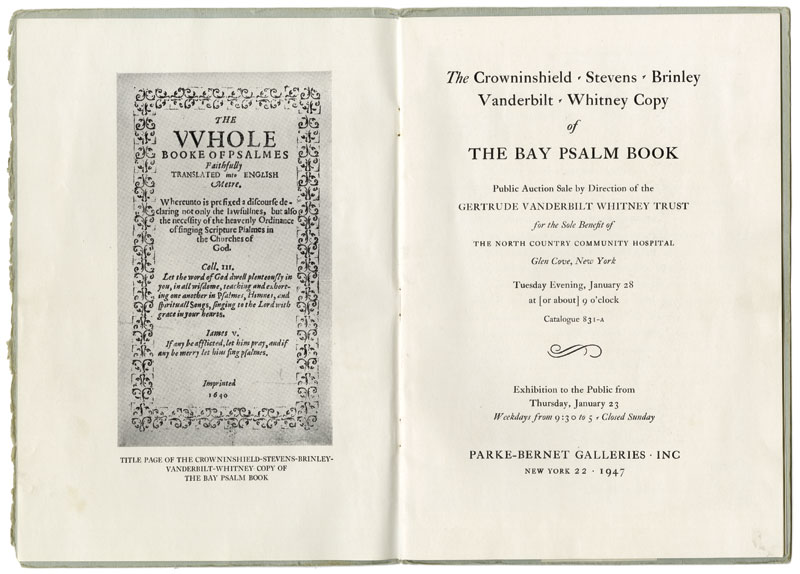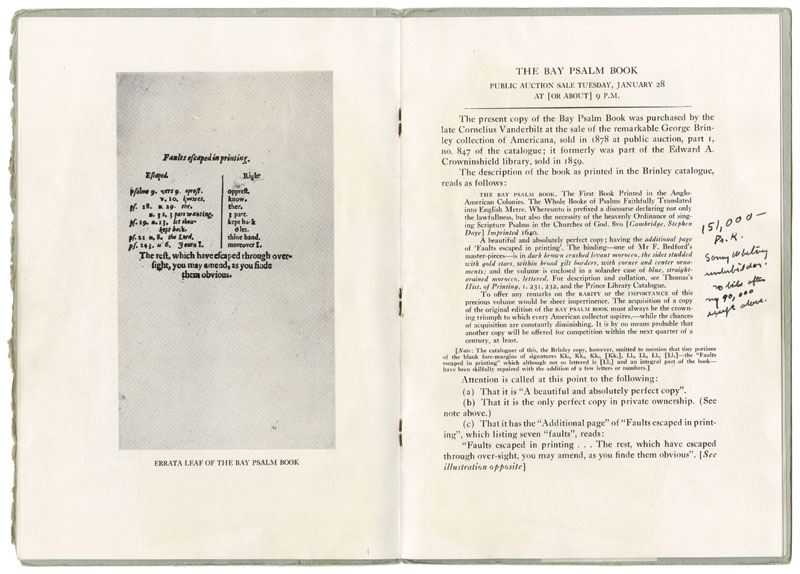The Mystique of the Bay Psalm Book
Unless it’s been stolen, it’s unusual for a rare book to be the subject of newspaper headlines, and until last December, the Bay Psalm Book ranked near the bottom of the list of publicly recognized book rarities, well behind the Gutenberg Bible, the Shakespeare First Folio, Audubon’s Birds of America, and Jane Austen’s Pride and Prejudice. But since it’s the first substantial product of the printing press in what is now the United States, as w'ell as a book that hasn’t appeared on the market during the collecting lives of nearly all present-day bibliophiles, there have been predictions that the book may bring as much as $20 million, which will far exceed the present record for printed books of approximately $11.5 million, which was paid in December 2010 for The Birds of America.
The Bay Psalm Book, printed in Cambridge, Massachusetts, by Stephen Daye in 1640, was the first book printed by the newly established Cambridge press. It was probably preceded by a small single-sheet production known as The Oath of a Freeman, of which no copy is extant. The Oath has also been the subject of a great deal of discussion, due to its forgery in the 1980s by Mark Hofmann of Salt Lake City, who produced printed copies of The Oath, one of which was offered to the American Antiquarian Society and the Library of Congress. Hofmann, who had also manufactured and sold a large number of manuscript forgeries, was heavily in debt, and the pressure of his financial affairs led him to commit two murders, before he was seriously injured himself by a bomb that he had constructed. In his forgery of The Oath, Hofmann made use of the ornaments and some of the typography of the Bay Psalm Book, and the close examination of Hofmann’s production, and its typographical inconsistencies, contributed to examiners’ conclusions that The Oath was a modern fabrication rather than a seventeenth-century original.
The forthcoming sale of the Bay Psalm Book will be an event long remembered in the world of rare books, just as its 1947 sale showed what can happen when a book that has an attraction to those who aren’t bibliophiles is sold at a public auction. In the 1947 auction, competition from a non-collector, Cornelius Vanderbilt Whitney, pushed the sale price to the unexpected level of $151,000. The volume was purchased by The Rosenbach Company on behalf of Yale University, but the hammer price far exceeded the commission bid that Yale and its benefactors had given Rosenbach, and in the complications surrounding the aftermath of the sale, the Bay Psalm Book made its way to Yale only after a sizeable contribution on the part of The Rosenbach Company.
Auction outcomes are difficult to predict, and the pre-sale publicity helped drive the 1947 sale price far above the $40,000–80,000 that had been expected. The opposite has also been true, as was the case in the auction at Sotheby’s in January 1855 of a portion of William Pickering’s stock. In that sale, a copy of the Bay Psalm Book went unrecognized by the auctioneers, but it was spotted amongst a group lot of books of Psalms by the flamboyant American bookseller Henry Stevens, G.M.B. (“Green Mountain Boy”). As Stevens reported, after the lot was knocked down to him for nineteen shillings, other booksellers wanted to know what he had spotted, and why he had paid so much for the lot. Stevens answered, “Oh nothing, … but the first English book printed in America.”
No one knows what the sale price of the Old South Church copy of the Bay Psalm Book will be, but the book won’t go unrecognized this time, and it’s certain to bring considerably more than nineteen shillings. And if the sale price is anything close to some of the current predictions, on that day, at least, the Bay Psalm Book will be the most famous book in the world.
Further Reading and Browsing A great deal has been written about the Bay Psalm Book, and much more will be written as its sale approaches. Jeremy Dibbell contributed a post to the Fine Books Blog about the Old South Church’s vote to sell the book, which links to an earlier posting on his own blog, PhiloBiblos, which contains a census of surviving copies of the Bay Psalm Book. The PhiloBiblos posting also provides references to some of the important literature about the Bay Psalm Book, including a 1903 facsimile, with a census and commentary by Wilberforce Eames (New York: Dodd Mead), and a link to an important article by Nathaniel Shurtleff and Bradford F. Swan, “Some Thoughts on the Bay Psalm Book of 1640: With a Census of Copies” (Yale University Library Gazette, vol. 22, no. 3, January 1948, pp. 51–76). Also well worth consulting is Zoltán Haraszti’s The Enigma of the Bay Psalm Book (Chicago: University of Chicago Press, 1956), which was published to accompany a Bay Psalm Book facsimile of the same year. Finally, George Parker Winship’s The Cambridge Press, 1638–1692 (Philadelphia: University of Pennsylvania Press, 1945), provides a very interesting and readable history of seventeenth-century printing in Cambridge.










